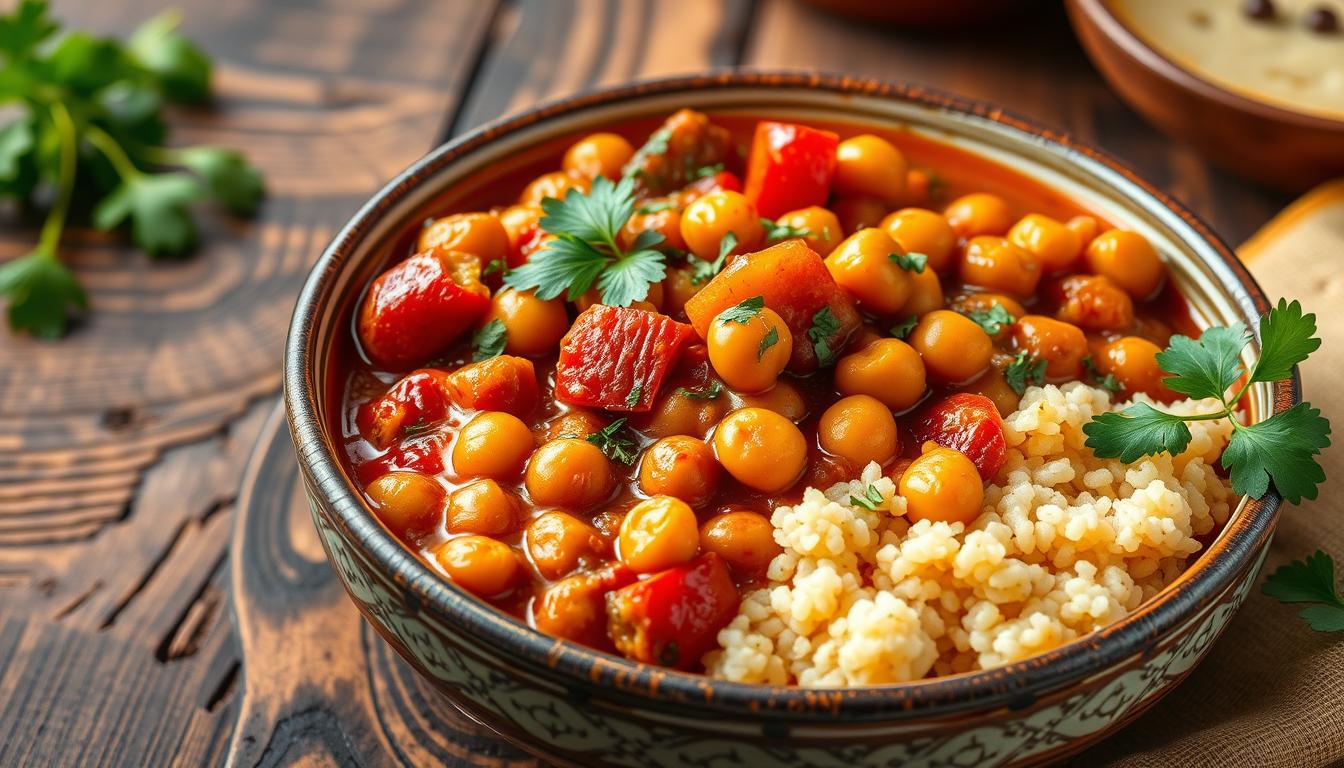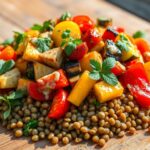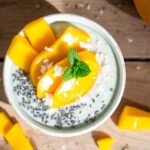The smell of warm spices fills my kitchen, taking me to Marrakech’s busy markets. Every time I make Moroccan chickpea stew, I think of the rich cooking traditions. These traditions turn simple ingredients into a special one-pot meal.
This stew isn’t just a recipe; it’s a journey through North African cuisine. It brings the lively spirit of North Africa right to your table. With just 30 minutes of cooking, you can make a dish that’s both nutritious and full of flavor.
Key Takeaways
- Discover the authentic flavors of North African cuisine
- Learn a simple 30-minute one-pot meal technique
- Explore nutritious and versatile chickpea recipes
- Understand the cultural significance of Moroccan cooking
- Master a flexible stew that adapts to various dietary needs
Introduction to Moroccan Chickpea Stew

Moroccan cuisine is a colorful mix of flavors. The chickpea stew is a perfect example of its culinary greatness. It’s more than a meal; it’s a journey through Morocco’s spice markets and kitchens.
Chickpeas are the main ingredient in this stew. They provide a nutritious base that turns simple ingredients into a culinary masterpiece. The magic happens when these protein-rich legumes meet the spices that are the heart of Moroccan cooking.
“A great stew tells a story of culture, tradition, and love” – Moroccan Culinary Proverb
- Prep time: 15 minutes
- Cook time: 45 minutes
- Total servings: 6
- Calories per serving: 243 kcal
This stew is loved by both vegetarians and meat-lovers. It can be ready in just over an hour. This makes it a satisfying meal that captures the essence of Moroccan spices and traditions.
| Key Ingredients | Quantity |
|---|---|
| Chickpeas | 2 (15 oz) cans |
| Turmeric | 1 tablespoon |
| Cumin | 1 tablespoon |
| Paprika | 2 teaspoons |
This Moroccan chickpea stew is special because of its spice blend. Each bite shares a story of generations of cooking skill. It turns simple chickpeas into a dish that’s both cozy and thrilling.
Essential Ingredients and Equipment
Making a real Moroccan chickpea stew needs the right ingredients and tools. Start by knowing what makes this dish special.
Key Spices and Aromatics
Moroccan food is all about its spices. The right mix turns a simple stew into a feast. Harissa, a spicy chili paste, adds a kick.
- Ground cumin
- Coriander
- Turmeric
- Cinnamon
- Harissa paste
Fresh and Pantry Ingredients
Choosing good ingredients is key for a true tagine stew. Make sure you have these basics:
| Fresh Ingredients | Pantry Staples |
|---|---|
| Chickpeas | Vegetable broth |
| Onions | Canned tomatoes |
| Garlic | Olive oil |
| Fresh herbs | Salt and pepper |
Required Kitchen Tools
You don’t need a traditional tagine to make this stew. Modern tools work great too. Here’s what you’ll need:
- Large cooking pot or Dutch oven
- Sharp chef’s knife
- Cutting board
- Wooden spoon
- Measuring spoons

Pro tip: Fresh spices make all the difference in creating an authentic Moroccan flavor profile.
Nutritional Benefits and Health Value
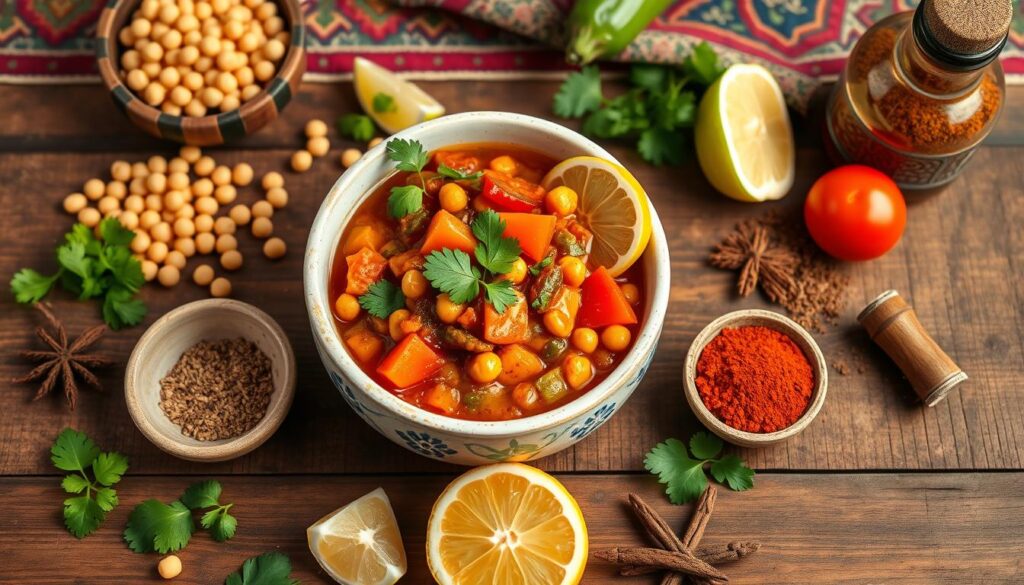
Your Moroccan chickpea stew is more than just tasty. It’s a nutritional powerhouse with amazing health benefits. This meal is full of plant-based protein and essential nutrients that boost your wellness.
Chickpeas are the heart of this dish, bringing incredible health perks. Here are the main nutritional highlights:
- High in plant-based protein (approximately 16g per serving)
- Excellent source of dietary fiber (8-10g per serving)
- Rich in vitamins and minerals
- Low in fat (approximately 7g per serving)
This dish is a nutrient-dense meal that supports health in many ways. Chickpeas give you lasting energy. Spices like cumin, coriander, and cinnamon add extra metabolic benefits.
“Food is not just calories, it’s information that tells our body how to function.” – Dr. Mark Hyman
Let’s look at the nutritional breakdown of this vegetarian stew:
- Calories per serving: Approximately 476
- Carbohydrates: 96g
- Protein: 16g
- Fat: 7g
Choosing this plant-based protein packed stew is a smart choice. It’s delicious and nourishes your body, supporting long-term health.
Traditional Moroccan Cooking Methods
Moroccan cuisine is a rich tradition that turns simple ingredients into amazing meals. It’s all about the special ways of cooking, like making stews and dishes.
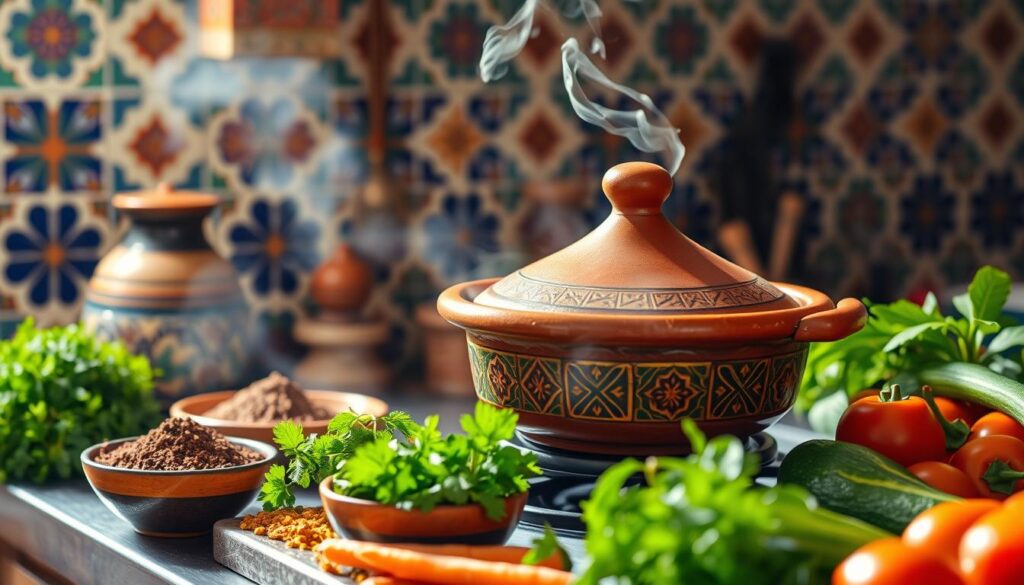
Exploring Moroccan cooking shows a world of art in the kitchen. The tagine, a clay pot with a cone-shaped lid, is key to real Moroccan food.
Authentic Tagine Techniques
Traditional tagine cooking has a few main points:
- Slow, gentle heat lets flavors grow slowly
- Steam from the lid keeps food moist
- Layering ingredients adds depth to flavors
- Using little liquid makes tastes stronger
“The magic of a tagine lies not just in its ingredients, but in its patient, loving preparation.” – Moroccan Cooking Proverb
Modern Adaptations
Even though old ways are loved, modern cooks have made Moroccan cooking easier. Now, you can make similar dishes with:
- Slow cookers
- Pressure cookers
- Dutch ovens
- Standard stovetop pots
These changes mean you can make delicious Moroccan food at home, no matter what your kitchen has.
Step-by-Step Preparation Guide
Making a tasty Moroccan chickpea stew needs focus on technique and layering ingredients. This guide will help you make a dish that captures the true taste of Moroccan cuisine. You’ll learn how to bring this delicious one-pot meal to your kitchen.
- Prepare Your Ingredients
- Gather fresh chickpeas, aromatic spices, and vegetables
- Chop onions and garlic finely
- Measure out cumin, paprika, and harissa
- Sauté Aromatics
- Heat olive oil in a large pot
- Cook onions on medium-low heat for 10 minutes
- Add minced garlic and spices
- Build the Stew Base
- Add chickpeas and vegetable stock
- Incorporate diced tomatoes
- Season with salt and pepper
- Simmer and Perfect
- Reduce heat and cover
- Simmer for 25-30 minutes
- Stir occasionally to prevent sticking
The secret to this Moroccan chickpea stew is its slow cooking. This lets the flavors meld together, turning a simple dish into a feast for the senses.
“Cooking is about passion, and the love you put into creating a meal reflects in its taste.” – Unknown Moroccan Chef
Pro tip: Start with 1 teaspoon of harissa and adjust according to your spice tolerance. The stew can be refrigerated for up to 5 days, making it perfect for meal prep.
| Nutritional Highlights | Per Serving |
|---|---|
| Calories | 364 kcal |
| Protein | 13 g |
| Total Carbohydrates | 59 g |
| Dietary Fiber | 13 g |
Mastering the Spice Blend
Exploring north african flavors means learning about spice blending. Moroccan cuisine is all about complex spice mixes. These mixes turn simple dishes into amazing meals.
Spices are the core of Moroccan cooking. They add depth and warmth to every dish. Each Moroccan region has its own spice mix, showing local traditions and what’s available.
Balancing Flavor Profiles
Making the perfect spice blend is all about how spices work together. Here are some key things to think about:
- Earthy base notes from cumin
- Warm undertones of cinnamon
- Bright hints of paprika
- Subtle ginger heat
- Grounding turmeric color
Regional Spice Variations
Different Moroccan regions have their own spice styles. You can make your chickpea stew reflect these by tweaking the spice mix.
| Region | Signature Spice Blend | Characteristic Flavor |
|---|---|---|
| Marrakech | Cumin, Coriander, Paprika | Robust and Smoky |
| Fez | Cinnamon, Ginger, Turmeric | Warm and Aromatic |
| Coastal Regions | Saffron, Cayenne, Cardamom | Bright and Spicy |
Pro tip: Start with small amounts when trying out spice blends. Aim for balanced flavor, not too much heat.
“Spices are the language of Moroccan cuisine, speaking stories of tradition and innovation.” – Moroccan Culinary Master
Slow Cooker vs Stovetop Methods
There are many ways to make a tasty Moroccan chickpea stew. You can pick between slow cooker and stovetop methods. Each choice affects the taste and ease of making this dish.
Cooking Method Comparison
| Cooking Method | Time | Effort Level | Flavor Development |
|---|---|---|---|
| Slow Cooker | 3-4 hours (high heat) | Minimal | Deep, slow-developed flavors |
| Stovetop | 30-40 minutes | Active cooking | Brighter, fresher taste |
If you’re always on the go, the slow cooker is great. Just mix everything together, set the heat, and forget about it. You’ll come back to a delicious meal.
Stovetop cooking lets you control the process and cook faster. Start by sautéing veggies to add more flavor. Then, simmer the stew until it’s just right.
“The best cooking method is the one that fits your lifestyle and brings joy to your kitchen.” – Moroccan Cooking Wisdom
Recommended Cooking Techniques
- Slow Cooker: Ideal for hands-off cooking
- Stovetop: Perfect for immediate meal preparation
- Instant Pot: Combines speed and flavor development
No matter your choice, your Moroccan chickpea stew will be full of rich, aromatic flavors. It will take you on a culinary journey to North Africa.
Serving Suggestions and Accompaniments
To make your Moroccan chickpea stew special, think about how you present it. Moroccan cuisine is not just about food; it’s about creating a feast for the senses. This includes how it looks and tastes.
Traditional Side Dishes
Classic Moroccan dishes pair well with your chickpea stew:
- Fluffy couscous
- Warm flatbreads (khobz)
- Fragrant basmati rice
- Fresh herb salads
Modern Pairing Options
Want to mix things up? Try these modern twists:
- Quinoa for added protein
- Naan bread for scooping
- Greek yogurt with a drizzle of olive oil
- Roasted vegetable medley
“The right accompaniment can transform a good meal into an unforgettable dining experience.”
Think about what your stew offers. It has 26g of protein and 78g of carbs. Pair it with these sides for a meal that’s both balanced and delicious, honoring Moroccan traditions.
Storage and Reheating Tips
Keeping your Moroccan chickpea stew fresh is simple. It’s great for meal prep and stays good for days. This lets you enjoy it all week long.
Refrigeration Guidelines
Let your stew cool down before you store it. Use a tight container to keep it fresh. It stays good in the fridge for 4-5 days, keeping its taste and nutrients.
| Storage Method | Duration | Recommended Container |
|---|---|---|
| Refrigerator | 4-5 days | Airtight glass or plastic container |
| Freezer | Up to 3 months | Freezer-safe container or heavy-duty freezer bag |
Freezing and Thawing Tips
Freeze your stew in single portions for longer storage. This makes reheating easy and helps avoid waste. Here’s how to thaw and reheat:
- Thaw overnight in the fridge
- Take 24-48 hours for full thawing
- Reheat slowly to keep taste and texture
Reheating Techniques
Use these methods to keep your stew tasty and tender:
- Stovetop: Warm on low heat, stir often
- Microwave: Start with 30-second bursts, stir between
- Add a bit of vegetable broth if it’s too dry
Pro tip: A squeeze of fresh lemon juice can brighten the flavors when reheating your one-pot meal!
Follow these tips to keep your Moroccan chickpea stew as tasty as the first time you made it.
Vegetarian and Vegan Modifications
Making a versatile vegetarian stew opens up a world of flavors. Your Moroccan chickpea stew can change to fit different diets. It keeps its rich, authentic taste.
Plant-based proteins can make your stew amazing. Here are some protein-rich options:
- Extra-firm tofu, cubed and lightly pressed
- Seitan chunks for a meat-like texture
- Additional legumes like green lentils
- Tempeh crumbles for robust flavor
Protein Boost Strategies
To boost plant-based protein, mix different ingredients. This stew already has 8 grams of protein. Adding more can increase it even more.
Vegan-Friendly Adaptations
For a vegan version, use coconut or almond yogurt instead of dairy. These keep the creamy texture and make the dish vegan.
“Eating plant-based doesn’t mean sacrificing flavor or nutrition.” – Culinary Nutrition Expert
Your Moroccan chickpea stew is a nutritional powerhouse. It has 8 grams of fiber and 25 grams of carbohydrates per serving. It’s great for those looking for healthy, filling meals.
Seasonal Variations and Substitutions
Your Moroccan chickpea stew is a versatile dish that can adapt to different seasons and ingredient availability. Whether you’re cooking in summer or winter, this recipe offers flexibility to keep your meal exciting and delicious.
Seasonal vegetable substitutions can transform your moroccan chickpea stew experience. During winter months, root vegetables shine as perfect additions:
- Butternut squash can be replaced with sweet potato or white potato
- Add robust winter vegetables like carrots and parsnips
- Increase warming spices for extra comfort
Summer variations bring lighter, fresher options for your moroccan chickpea stew:
- Incorporate zucchini and bell peppers
- Reduce heavy spices
- Serve chilled or at room temperature
“Cooking is about adaptation and creativity – let your ingredients guide you!”
When ingredients are scarce, consider these smart substitutions:
- No fresh tomatoes? Use canned whole tomatoes (28 ounces work perfectly)
- Swap vegetable broth with water and additional spices
- Use dried or canned chickpeas based on availability
Your moroccan chickpea stew can be a year-round favorite with these simple modifications. Experiment and enjoy!
Conclusion
Your journey into Moroccan chickpea stew is more than a recipe. It opens the door to North African flavors. This dish is a key to a world of taste and tradition.
The Moroccan chickpea stew is simple yet rich. It’s full of 10 grams of protein and 12 grams of fiber. Sweet potatoes and chickpeas together make a dish that’s good for you.
Cooking is all about being creative. Try different spices, swap veggies, or change ingredients to your liking. This stew is perfect for any meal, whether it’s a quick dinner or a special occasion.
Let the Moroccan chickpea stew warm your heart and inspire your cooking. It’s just the start of your culinary journey.

